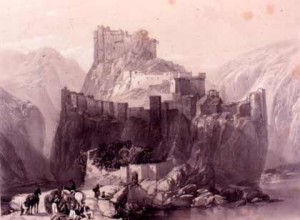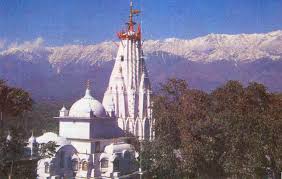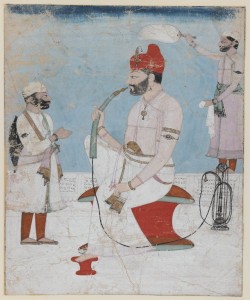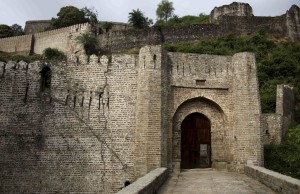KANGRA AND THE MYTH OF SCHOOLS OF ART OF PAINTING
ZERO PATRONAGE OF ARTS BY THE RAJAS
M A Rahman Chughtai’s visit to Kangra for exposures of Art

People talk of KANGRA all the time, without knowing anything about Kangra. The great Kangra Fort was in the eyes of the Mughals and its annexation was proving difficult. It was in 1621-22 AD that Emperor Jahangeer captured Kangra and built a mosque there. Kangra remained under the Mughals till 1783 when due to the waning conditions of the Mughal kingdom, it was captured by others. So pseudo historians would have us believe that in the course of a few decades the educated new Rajah developed a school of Art out of the blues. Shame on such people for demeaning the Mughal kingdom and making rats Rajah of great background and there is no doubt that Raja Sansar Chand was a mean person, hated by the people of Kangra. In the 1920s when MARC visited Kangra and asked an artist Hazuri there about the patronage of the Rajahs, tears came in the eyes of Hazuri, the last living artist of that area. He said we are considered worse than MOCHIS here and the RAJAHS do not patronize us, they steal what we make without paying for it. This is the Sansar Chand whose family is supposed to have given two artists to their daughters as dowry. Hogwash!

It is one of the oldest forts of India but it was first captured by Sultan Mahmud Ghazni in 1009 AD. By Muhammed bin Tughlaq in 1337 AD and then by Firuz Shah Tughlaq in 1351 AD. When Jahanger captured it in 1621-22 AD and he writes about it in his memoirs, he appointed Nawab Saif Ali Khan as its first Mughal Governor. A proud inscription was placed on the Jahangeeri darwaza there. Brought to Lahore by Nau Nihal Singh, the inscriptions of Kangra fort were transferred to Lahore Museum and they are still there with them. So to suppose that Mughal culture would not be at Kangra Fort is literally a load of crap.

Kangra was famous for four things:
1. Manufacture of new noses (yes some sort of plastic surgery was here). Home for thieves.
2. Treatment of eye diseases.
3. Basmati rice.
4. Strong fortress.
Nowhere it is mentioned that Kangra was famous for painting too. This is an innovation of 20th century.
The story is told like this. Raja Sansar Chand sent artists to Lahore and started a new school here. Spare me this bullshit! Lahore is a 1000 years old Muslim city with heritage of Painting from day one. Sultan Mahmud Ghaznavi had brought artists from Ghazni here and later Sultans developed a school of art based on Chinese culture. That is why we have a Sultanate School of Painting here. Kangra did not give any style here, Lahore gave style to Kangra, and we well understand that. This is merely a blog. M.A. Rahman Chughtai’s DABISTAN book has been translated into English and will be published soon.

The simple truth is that the famous art dealer of Amritsar Bharani used to sell works to various people and to romanticize his sales, he fixed names to them. All the names we currently use are the names given by the Paintings wizard salesman Bharani and my father very well knew this and he had asked Bharani this question. Bharani used to say the more alluring the background, the better the thing sells, and he narrated his experience of the Englishman. An Englishman walked in his shop in Amritsar and wanted to buy a painting. Bharani asked for Rs 100. The Englishman wanted to reduce the price. Bharani said that he will tear the work but will never give for less than 100 Rs. The Englishman smiled and taunted him to tear it. Bharani tore the painting. The Englishman was shocked and asked what he wanted for the painting then in torn condition. Bharani said Rs 200. Annoyance reached its zenith, when the man said, for an untorn painting it was Rs 100, for a torn work Rs 200. Are you mad? He said mad, I may be, but I will not take less than 200 Rs. In the end the Englishman bought the torn picture for Rs 200. That was the strength of Bharani, he knew the heart of all his clients very well.
The style of various different artists are based on the style of the uprooted artists of the Mughal Court and everybody knows that. Fear of people like Nadir Shah and Ahmad Shah Durrani, made them run to the hills, in search of living, these poor painters reached out to the people. By drawing mythology as well as Rajahs, they were trying to make a living from normal people of the area. The Arch School creator William Archer became so confused in the end with his analysis of things, that as told to me by Doris Wiener, he committed suicide. He could not reconcile the divergences of his research. May God bless him!

A new approach for research students and scholars. Open your eyes and think and feel the passion of art and artists
A remarkable statement is based on the book HINDOOSTAN by Frederick Shoberi in the early 19th century when he says that the Hindu painters are actually MOCHIS (shoe makers) and alternate professions. So when Hazuri says that they are treated worse than Mochis, it means they are Mochis themselves. Never the artist as a high bred worshipped fankar as sung in stereotype versions today. That job was the work of Muslim Kings and Sultans who took the artist high up in the pedestal of life.